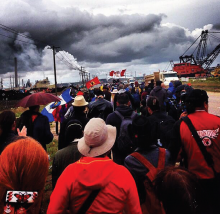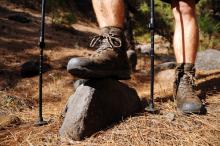Creation Care
As the Creation Care campaign associate at Sojourners, my job is to get people thinking about God’s call for us to care about the creation. Usually, I do that from behind a desk in Washington, D.C., but recently I got to do it from a boat out on the bayou in Louisiana, in a tiny community that has been hit by eight disasters in eight years (seven hurricanes and the Deepwater Horizon oil spill). I took 100 people out to the town of Jean Lafitte, less than an hour from New Orleans, to hear from people who live on the front lines of climate change.
One of the obstacles to igniting a passion about climate change is that it feels so abstract; it feels like a future problem, a global problem. But it’s really a here and now problem. We took folks out on the Louisiana bayou to meet with those who are living in the midst of climate change – people who don’t think of themselves as environmentalists, but who can bear witness to the impact that climate change and our use of dirty energy have had on their lives, personally.
The town of Jean Lafitte is an old and diverse town, a close-knit community where faith is important to many people, including the mayor. It’s a town that sounds a lot like the early Christian church. We were told that homelessness is not a problem there – if your neighbor loses her home, why wouldn’t you take her in? We were told that when the state government showed up two weeks after Hurricane Katrina, the town had recovered so quickly that the government thought the hurricane hadn’t hit them. This community comes together, and because it knows how to survive, it often gets forgotten by government responders and by oil companies like BP.

I always thought of climate change as something that affected developing countries. Through my work at World Renew, an international disaster response and community development organization, I am well acquainted with the devastating effects of changing growing seasons in Africa and environmental refugees in Bangladesh. I probably shouldn’t have been so surprised to learn that there are ecojustice issues here in the U.S. — but I was.
Last week I had the opportunity to tour the town of Jean Lafitte just outside New Orleans. Hosted by Sojourners, it was one of the “Go and See” options during the Christian Community Development Association conference.
Our tour began with a presentation by the Rev. Kristina Peterson and Mayor Tim Kerner at the Jean Lafitte National Historical Park and Preserve. There we learned that since the 1930s, Louisiana has lost a football field of wetlands every 38 minutes. At the current rate, the state will lose an area of wetlands the size of Rhode Island by 2050. According to Peterson, 36 percent of the wetland loss can be attributed to the activities of the oil and gas industry — in particular, the canals they carve out.

In my state of Minnesota, there are literally hundreds of faith-based green teams doing a variety of good works. We’ve collectively tackled solar panels and bike racks. We’ve individually been consuming less, doing energy audits of our homes, and taking action in our neighborhoods. It is important work. And yet when I talk to the lay leaders in these congregations, they report that enthusiasm has waned and that their groups have become stale. As one tired (and yet tireless) leader confided in me: “I don’t know what it is, Julia, but it’s like we are swimming in molasses.”
As the new executive director of Minnesota Interfaith Power & Light I am trying to pay attention. What is this feeling of stuck-ness? If it’s not working, what then is the special sauce that will help these tireless leaders to ignite their communities?
A few observations about humans:

This Wednesday on Capitol Hill, the House subcommittee on Energy and Power held a hearing to discuss the Obama administration’s climate change policies and activities. The policies in question were the president’s Climate Action Plan, announced this summer, which has three main pillars:
- cutting carbon emissions,
- leading international efforts to combat climate change, and
- preparing the United States for climate change impacts.
The Environmental Protection Agency Administrator Gina McCarthy and the Energy Secretary Ernest Moniz were present to answer questions about the president’s plan, which works with new and existing programs in both agencies to reduce our climate change pollution and increase our resilience to climate change. Some of the programs are required by a recent Supreme Court decision that labeled carbon dioxide a pollutant; others, as Moniz pointed out, would happen to carry the benefit of energy efficiency.
For some members of Congress, this is a problem because they do not wish to cede any ground to the executive. For others, it is a problem simply because they do not wish to do anything about climate change.

David vs. Goliath: Residents in a Colorado city are fighting their local coal monopoly for the chance to move their city to clean energy. The coal company has more money – a LOT more money – but the organizers have more heart. This short 6-minute video is well worth watching.
40,000 jobs sound pretty good: According to the new 2013 second quarter clean energy report form Environmental Entrepreneurs (E2), clean energy and sustainable transportation projects launched this year created close to 40,000 green jobs in the U.S.

Pipeline projects are moving forward across the country, but a group of tuneful nuns is working to make sure they don’t succeed.
The Sisters of Loretto in Marion County, Kentucky have lived on their rural acreage since the 1800s, serving the poor and enjoying the wide open spaces and forest trails of their home.
With a fracking company proposing a pipeline for pressurized natural gas chemicals through their land, the sisters have sprung into action to protect what they see as their “holy land.” They have refused to allow the fracking company to survey their land for pipeline construction, citing past pipeline explosions and the risk of contamination.
The sisters appeared at a public hearing over the proposed pipelines, singing “Amazing Grace” until they were asked to be quiet. Their unexpected activism has gained them attention locally and across the internet (you can meet the sisters by watching this video.)

I love Netflix. I love that from the comfort of my couch, I can watch almost an endless selection of movies and TV shows. I’m re-watching all of The West Wing right now, along with most of Washington and probably much of the country. My friend Kat told me recently that she and her fiancé are watching it for the fifth time on Netflix, despite it sitting in a deluxe DVD set above their TV. Why get up to switch DVDs when your streaming player automatically starts the next episode for you?
So I wasn’t too happy when I read that my Netflix habit is seriously energy intensive. In a new article on Salon.com, I learned that watching Netflix streaming for an hour a week uses more energy each year than two new refrigerators. In my household we definitely watch a lot more than an hour a week.

Fred Bahnson’s first bit of advice when he started planning a church garden eight years ago came from an elderly tobacco farmer who grabbed a handful of soil, rolled it around in his fingers and shook his head:
“You don wohn fahm heah,” he said in his deep North Carolina drawl.
Those were not the only discouraging words he received as he planted and cultivated one of the earliest and most successful church gardens, 20 miles north of Chapel Hill.
But Bahnson, a Duke Divinity School graduate and a pioneer in the church gardening movement, had a different view of farming than the older tobacco farmer. He knew that if he gave back to the soil more than he took out — in the form of compost, manure and other soil food — he could create an abundant garden.

Editor's Note: The following is an excerpt from Fred Bahnson's new book Soil and Sacrament: A Spirtual Memoir of Food and Faith.
The garden is our oldest metaphor. In Genesis God creates the first Adam from the adamah, and tells him to “till and keep” it, the fertile soil on which all life depends. Human from humus. That’s our first etymological clue as to the inextricable bond we share with the soil. Our ecological problems are a result of having forgotten who we are—soil people, inspired by the breath of God. “Earth’s hallowed mould,” as Milton referred to Adam in Paradise Lost. Or in Saint Augustine’s phrase, terra animata—animated earth.
The command to care for soil is our first divinely appointed vocation, yet in our zeal to produce cheap, abundant food we have shunned it; we have tilled the adamah but we have not kept it.

Environmental activist Bill McKibben took part in the July 5-6 Healing Walk, a spiritual gathering in northern Alberta, Canada, focused on the destruction—to the immediate environment and to the climate itself— caused by tar sands oil extraction and the Keystone XL pipeline across the U.S.
TO WALK, SLOWLY, across the tar sands complex of Alberta is to see our real-life equivalent of The Lord of the Rings’ Mordor. It really is as bad as everyone says. On this one eight-mile loop, we saw vast stretches of muskeg turned into dry, sandy desert; we saw dry-sandy desert that had been further converted into inky tailings lakes; and we were never out of earshot of the cannon that fire all day and all night to keep ducks from landing in the toxic waters. This goes on forever. The most comprehensive way to see it is from the air, I guess, but the best way to feel it is on foot.
Especially if you’re walking with the people who know this land best—have known it for thousands of years. Each year since 2010, local First Nations groups have organized a Healing Walk through the tar sands, and this year’s fourth iteration was by far the largest. Hundreds of people from around the continent camped for several days in a stretch of nearby boreal forest, held workshops and ceremonies, and then emerged for the hike through the industrial barrens.
THE LEADERSHIP of 12Stone Church, a multi-campus congregation based in Gwinnett County, Ga., became increasingly concerned about how home foreclosures, rampant unemployment, and other financial strains were impacting families in metro Atlanta. They set an ambitious goal of providing relief to 5,000 families in their church and community. Eventually they raised more than $550,000 through designated gifts, many from church members who were themselves unemployed.
Partnering with the HoneyBaked Ham Company, Kroger grocery stores, and other area sponsors, the 12Stone Church members distributed food to needy families, culminating with a day of giveaways in the parking lot of Coolray Field, home to the Gwinnett Braves, the local minor league baseball team. People began lining up hours before the event, jamming traffic on nearby I-85. Others slept in their cars overnight to keep from missing out.
Imago Dei Church in Raleigh, N.C., has mercy ministries built into the DNA of the church. They’ve adapted Rick Warren’s PEACE Plan: plant churches, evangelize the world, aid the poor and sick, care for the orphan and the oppressed, and equip leaders.
Working through the Raleigh-based nonprofit Help One Now, Imago Dei is partnering with an orphanage in Haiti and sponsoring children. Through this ministry, the church is providing basic needs, including food, clean water, and health care. They also support education programs so that the children will be equipped to one day provide for their own families.

During the week leading up to the “Summer Heat” demonstrations — protesting the Keystone XL pipeline and urging for action on climate change — about 25 people started a hike from Camp David to Washington, D.C. Midway through the 100-mile hike, they were joined by another 50 people at Harper’s Ferry, W.Va. They called their journey the “Walk for Our Grandchildren.”
The name gives away the motivation — the walker’s sense of duty to future generations to leave a healthy planet. When they reached DC, many were arrested in an act of civil disobedience at the offices of Environmental Resources Management, a consulting firm given the task of writing the environmental review of the Keystone XL pipeline — a firm which also works for TransCanada, the energy company seeking to build the pipeline. Many others spent that Friday night at a church, and joined the Summer Heat demonstrations at the White House the next day.
Climate change is expected to take a turn for the better following the Senate's approval of Gina McCarthy to serve as the new head of the Environmental Protection Agency. McCarthy won over the Senate on July 18 in a 59-to-40 vote. The New York Times reports:
The president told Ms. McCarthy that his environmental and presidential legacy would be incomplete without a serious effort to address climate change.
Read more here.
Expressing her opinion that climate change is no longer about energy efficient behavior but rather about national policy, spiritual leader Marilyn Sewell argues the importance of what it takes to preserve the Earth’s atmosphere. Expressing her concerns about the lack of community and church involvement, Sewell insists policy immersion is crucial toward resolving future matters surrounding climate change. The Huffington Post reports:
So where is the parish church in all of this? Mostly silent, it seems. Churches continue to be concerned with individual sin as opposed to systemic sin, even in regard to climate change. Congregants may be admonished to recycle and change their light bulbs, but not to become politically active. The fact is we're way beyond changing our light bulbs. We need to bring that unhappy, startling truth to the pulpits of our land.
Read more here.

On Ash Wednesday 2013, civil rights legend Julian Bond and I found ourselves crammed into a prisoner transportation vehicle. We had just been arrested for protesting the Keystone XL pipeline at the White House. With our hands cuffed behind our backs, we made the most of our time. We shared stories of the civil rights movement and climate activism.
I asked him what single ingredient was most essential for the success of the civil rights movement.
He responded: “Persistence.”

My heart is in creation care. And frankly, it’s stressful. Every day, I learn about new things that are harming the environment. Another species is extinct. Another oil spill has spoiled a neighborhood. Plastic micro-beads in soap are clogging up the Great Lakes. The list is never-ending, and defeating.
But the other day, a Bible verse came to mind. It’s the one where we learn that not one sparrow falls to earth without God noticing. And while the next verse tells us that this is how we know God is especially watching over us, I want to pause for a moment and consider the sparrow part of the equation.
In a report obtained by the Los Angeles Times, the Energy Department said Thursday that power plants are at risk of being shut down due to the effects of climate change. With the rise of temperatures and sea levels and decreased water resources, the Energy Department advises officials to become more environmentally aware of their natural disaster plans as their ideas could permanently affect the future of Earth's climate. The Los Angeles Times reports:
The report calls on federal, state and local governments to more urgently prepare crucial infrastructure - particularly coal, natural gas and nuclear plants - for the compounded risks posed by floods, storms, wildfires and droughts.
"All of our science goes in one direction: The damages are going to get worse,” Assistant Energy Secretary Jonathan Pershing said. “It will take dozens of actors from government and private sectors planning what to do and how to make it cost-effective.”
Read more here.

Columbia, Mississippi is a small rural town most known as the home of Walter Payton, NFL player for the Chicago Bears. It is also my home — the place where I was born and raised.
On January 1, 1992, Jesus People Against Pollution was founded in Columbia. Residents had discovered that the town had been heavily polluted from the Newsom Brothers/Old Reichhold Chemical Company facility, now closed but still registering high levels of hazardous waste — what the EPA calls a “Superfund site.”
In March 1977, the plant exploded and wrecked the facility and surrounding community. The Old Reichhold Chemical Company abandoned their facility and hired an inexperienced contractor to dispose of the remaining toxins left on the site.

When you think of an evangelical Christian, do you think of a climate scientist who is passionately concerned about the impact of climate change?
After this week, you should.
Over 200 top scientists who identify as evangelical Christians from across the country released a letter this week calling on Congress to act on the moral and scientific imperative to address climate change. The letter — framed in scripture — points to the call to care for the poor and steward God’s creation as key elements contributing to their concern.